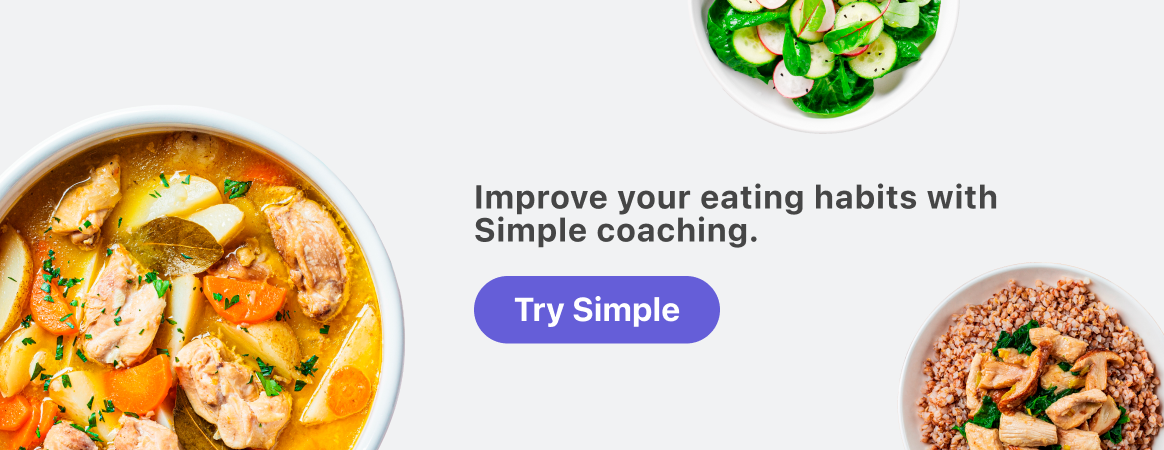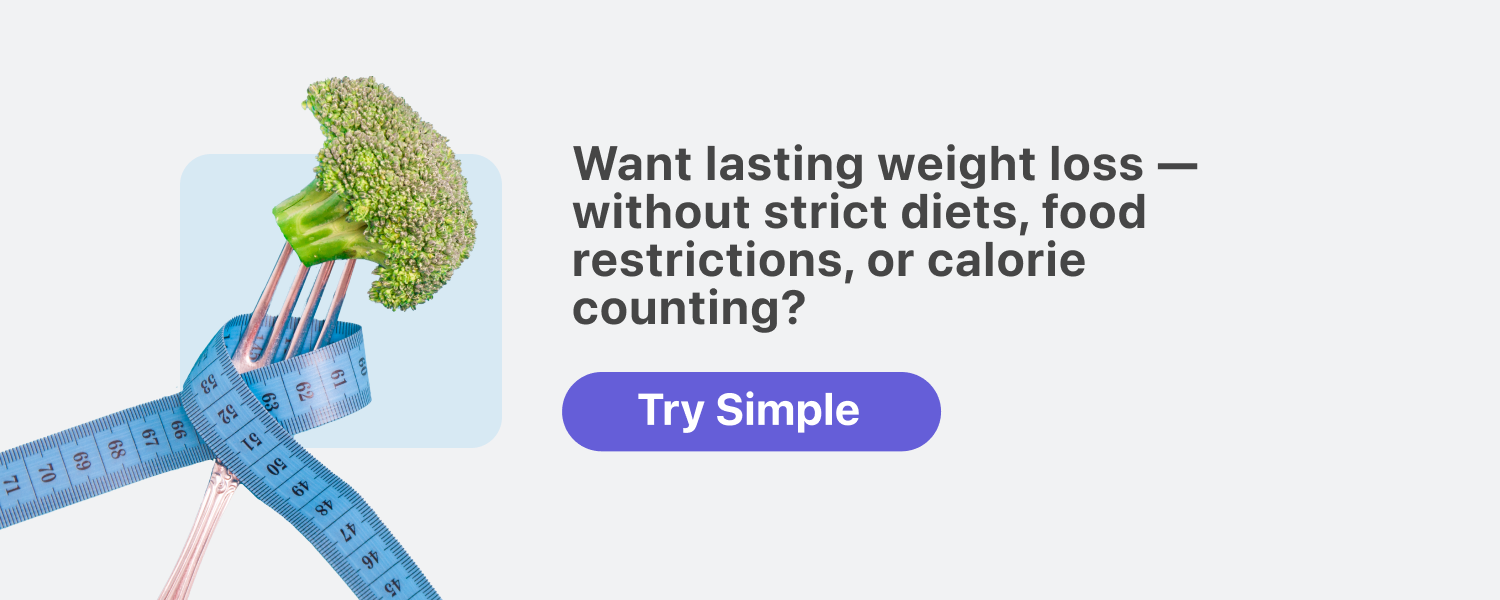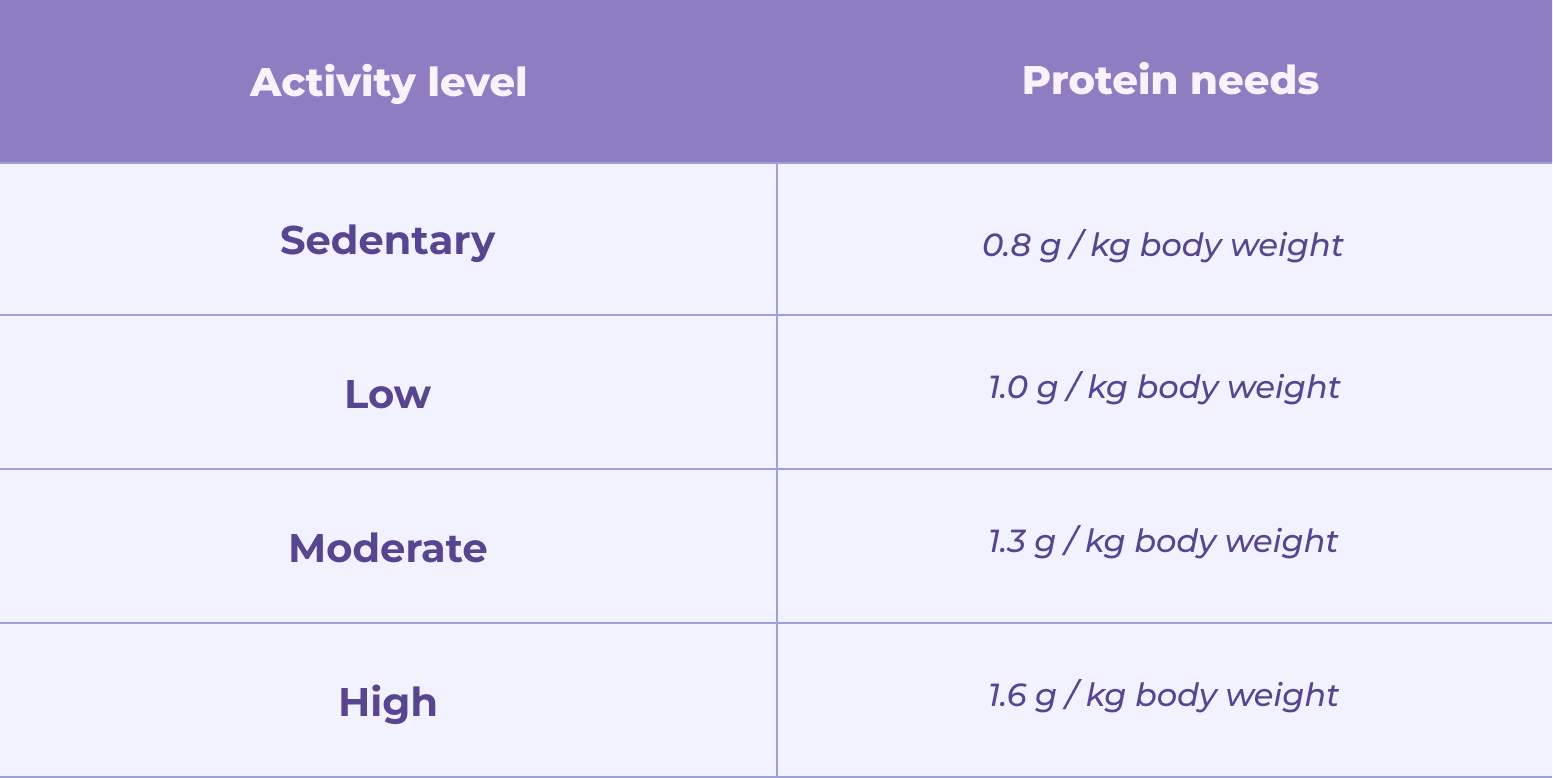Simple’s macro calculator: calculate your macros for weight loss and muscle gain

Our macro calculator is free, easy to use, and takes all the guesswork out of how much protein, carbs, and fat to eat to reach your goals.
Whether you’re on the muscle gain train or focused on fat loss, once you’ve calculated your personal macros with our calculator, you’ll know exactly what to eat every day to make consistent progress toward your goals.
How to use Simple’s macro calculator
Step 1: Input your sex, age, height, and current weight.
Step 2: Choose your daily physical activity level.
Step 3: Choose your goal.
Our macro calculator will give you a daily calorie target and how many grams of protein, carbs, and fat you need each day.
What is a macro calculator?
A macro calculator is a quick, easy way for men and women to find out the amount of calories, protein, carbs, and fat to eat to reach their goals — whether that’s gaining muscle, losing weight, or improving athletic performance.
If you’ve ever wrestled with a nutrition textbook to figure out how much protein you need to build muscle, how many carbohydrates you need to power your exercise, or how to multiply your basal metabolic rate (aka the amount of calories you burn at rest) to figure out your calorie needs, you’ll appreciate the ease of this calculator.
Today, all you need to do is shout, “Yo Simple — calculate my macros!” (and input your details), and we’ll do all the work for you.
How does it work?
Research shows different goals require eating different amounts of protein, carbohydrate, and fat. These amounts also vary based on your age, sex, and activity level.
A macro calculator saves you time, energy, and brain space by working everything out for you. You get simple guidelines to follow to achieve the results you want without the headache of crunching the numbers yourself.
Our free macro calculator works for weight loss and weight gain, so whether you want to slim down or beef up, this is for you. It’s also for you if you don’t want to do either of those things — nutrition has benefits far beyond just toggling your weight up and down.
Macronutrients — what are they?

Macronutrients are the three primary nutrients we find in our food: protein, carbohydrates, and fats. (The nutrients we find in our food in lesser amounts — like vitamins, minerals, phytonutrients, etc. — are known as micronutrients.)
These three macronutrients have various jobs in the body.
Protein
Protein repairs and rebuilds our body. It’s used to make muscle, bone, connective tissue (like tendons and ligaments), skin, hair, and nails, as well as enzymes and many hormones like neurotransmitters (brain chemicals).[1]
Ideally, prioritize lean, minimally-processed protein sources, like chicken, turkey, pork, lean beef, tofu, tempeh, fish, seafood, eggs, Greek yogurt, and cottage cheese.
Carbs
Carbohydrates are our body’s and brain’s preferred energy source.[2] The higher-fiber kind (like veggies and beans) keeps us full and helps ensure a happy bowel.
Ideally, prioritize minimally processed, whole-food carb sources like oats, quinoa, pasta, rice, fruit, white / sweet potatoes, beans, lentils, corn, and plain yogurt.
Fats
Fat is an energy source (as you’ll know if you’re intermittent fasting and experiencing ketosis regularly).[3] It’s also part of what makes up our cell membranes, brain, and nervous system, and it helps us make hormones.
Ideally, prioritize whole-food, mostly unsaturated fat sources like extra-virgin olive oil, avocados, nuts and nut butters, seeds, egg yolks, and olives.
Wondering which foods to choose? Try asking Avo, the wellness assistant within the Simple app. Avo can help you create a custom menu without all the guesswork. To get Avo on your team, take the Simple quiz and create your account.

Why is tracking your macros important?
Macronutrients (and micronutrients) are what our bodies are made of and what they run on. As such, your body needs a certain amount of protein, carbs, and fat to function and perform at its best.
You could muddle through, hoping you get enough of each one. But that’s not a reliable way to meet your body’s needs. It’s very easy to undereat protein and overeat carbs and/or fat, especially in today’s food climate where hyper-palatable foods are everywhere, stress is high, and the price of fresh fruits and vegetables always seems to be going up.
Macro counting can simply be a way to ensure you are satisfying your body’s nutritional needs.
If you have a specific goal — like improving your body composition by losing weight and gaining or preserving muscle — counting your macros can be an effective way to push the pace of your progress. You don’t have to do it forever. But as a way to understand the impact of different foods on how your body looks, feels, and performs, it’s a valuable thing to do, at least for a while.
The goal of counting your macros
There are three goals that tend to benefit from macro counting:
- losing weight
- gaining muscle
- making sure you hit all your body’s nutritional needs
Let’s look at how each one shakes out.
Weight loss
When you lose weight, you can lose body fat, water, bone, and muscle.
Most people want to lose body fat. But if you’re counting calories without paying attention to your macros, it’s pretty easy to lose the other stuff, too.
- Cut your carbs too low, and you’ll lose water weight [4] because as your body clears out its glycogen stores, water goes with it. Plus, your energy levels will drop, making it harder to exercise, and that can decrease your muscle mass (“use it or lose it” is a real thing).
- If you don’t get enough protein, your body will start shedding muscle.[5] Without enough of the material that makes it, it’s harder to keep hold of. That makes it more difficult to lose body weight and keep it off because muscle is a metabolically active tissue — i.e., it burns calories just by existing. The more muscle you have, the more calories you burn, period.
- Weight loss relies on you eating less than you burn, but without sufficient protein, hunger is harder to manage. Eating more protein-rich foods keeps your appetite satisfied and your cravings under control for longer and with fewer calories than fat- or carb-heavy foods.
- Eating enough fat gives you energy and helps you feel full (and makes your food taste better).
- Not overdoing fat also matters because, at 9 kcals per gram, it’s more calorie-dense than carbs and protein (both 4 kcals per gram). If too much of your daily calorie intake comes from high-fat foods, it’s easy to hit (or overshoot) your calorie target without getting all the nutrients you need, leading to more hunger and cravings and less energy to exercise.
If you calculate your macros for your weight loss goal, you’ll likely lose fat more easily while preserving muscle and enjoy being less hungry, even while eating less food.
Muscle gain
To build muscle, you have to gain weight, which means eating more calories than you burn (known as a calorie surplus). Those extra calories all have a job to do, and that makes macro counting a smart choice.
- Having a calorie surplus target can make it easy to go overboard on high-fat, high-sugar foods because you have the calories to accommodate them. Counting your macros makes it easier to keep your nutrition quality in check, so you put on muscle weight rather than fat weight.
- As we’ve seen, muscles are made of protein. You need enough protein in your daily diet to both repair and build that precious lean muscle mass.[5]
- Resistance training provides your body with the stimulus to build muscle.[6] But regular weight training takes energy. That energy comes primarily from eating enough carbs, though eating enough fat is also in the mix.
Calculating your macros for muscle gain means you can eat the most effective nutrient ratio to bulk up. Whether you just want to get ripped or you’re dipping a toe into bodybuilding, use our calculator to help lock in your numbers.
Body weight maintenance and health goals
Getting enough of each macronutrient supports your body to function and perform well throughout life. As each macronutrient has several essential jobs to do in the body, identifying your best ratio of macronutrients and calories using a calculator like ours can help you meet other health goals, too.
For instance, perhaps you:
- want to watch the quality and quantity of carbs in your diet because you have pre-diabetes
- are eager to regulate your fat intake because you’re at risk of high cholesterol
- do a lot of intense exercise and want your overall nutrition to support your activity levels
- want to eat enough protein to help preserve your muscle mass as you age
If your goal is to stay as you are — i.e., neither lose nor gain weight — you can still use our macronutrient calculator to help you hit the right balance of foods.
Whatever your goal, we can help you get your nutrition game on point. Take our quiz to log your meals and snacks in the Simple food tracker and learn how they stack up in terms of healthy nutrition. Are your food choices lining up with your goals? Log them in Simple and see!
The pros and cons of a macronutrient-based diet

Like all approaches to managing nutrition, there are pros and cons of using a macronutrient split to guide what you eat. Let’s weigh up whether this approach could be a good fit for you.
Pros
Pros include:
- Being clear about what and how much to eat to achieve your goals. No more wondering and worrying!
- Improved results. Consistently hitting your macros gives your body the nutrition it needs to change in the way you hope it will.
- Feeling good. Eating enough protein, carbs, and fat (and veggies!) for your body is a great way to feel energized, nourished, and alert.
- Less guessing if you’re plant-based. Eating a plant-based diet can leave you short on protein. Tracking your macros can help you make meal and snack plans based on what you need to close the gap.
- Room for noms. When you have your macros on lock, you can see where your favorite foods fit in. There’s room for all the foods you like in your diet, whatever your goal. It’s simply a matter of quantity and frequency.
- You’ll learn more about food composition. Using a macro counter to track your food means you’ll learn how much protein, carbs, and fat are in the foods you eat often. More nutrition knowledge means a greater ability to make food choices that support your goals, which in turn means better results!
- Becoming less food-focused — if you relax and let the calculator do the work. Macro counting can take some of the decision-making out of your daily food choices. Once you’ve got a good rotation of meals that hit your macro targets, you can set this thing to cruise control and stop thinking about food so much. For instance: Should you eat that brownie? Well, does it fit your macros?
Cons
Cons include:
- Weighing, measuring, and tracking everything you eat. Counting macros takes energy and time every day and can get tedious after a while.
- Becoming overly focused on food. Ideally, you’ll be less focused on food (as we mentioned above). But counting macros does require more awareness about what you’re eating. For some people, that can trigger disordered eating habits around controlling their food intake.
- Enjoying food less. Times when food is untrackable, like going out to eat, can become stressful rather than enjoyable. For some, tracking macros can make eating a chore rather than a pleasure.
- You won’t always be able to follow your appetite cues. If you’re using a macro counter to help you lose weight, sometimes you’ll hit your targets yet still feel hungry. If you’re tracking macros to gain muscle, sometimes you’ll be full yet still have calories to get. Them’s the breaks with this approach.
Calculating and tracking your macros — the results
Using a macro counter has been shown to be effective in helping people lose weight [7,8] and keeping it off long term.[9]
Eating plenty of protein also helps you recover from exercise and thus gain muscle over time.[5,10,11]
That said, the success of this approach depends on how you respond to it. The best way to achieve your goals is always the approach that fits into your life with the least stress. If it suits you, your needs, and how you like to live, you’re on to a winner.
So, if you find macro tracking empowering and it genuinely helps you focus on your goals, go for it. It can help you be more consistent and accurate with what you’re eating, and you’ll reach your goals more easily.
But, if you find it overwhelming, it distracts you from doing what’s really important (in life or for your goals), or it pushes you toward disordered eating habits, ditch it. Macro counting is not the only game in town. You’ve got options!
Intermittent fasting — no macros needed

You may already know that intermittent fasting can help you lose weight and improve your health. But did you know that intermittent fasting is also a good choice for muscle gain? News flash — it is!
Let’s explore how to use intermittent fasting — where there’s no need to calculate any macros — for weight loss and muscle gain.
Intermittent fasting means:
a) eating all your meals and snacks inside a specific time period (known as an eating window), and
b) having a regular number of hours each day where you don’t eat or drink anything containing calories (known as a fasting window).
For example, if you were on a 16:8 fasting schedule, you’d fast for 16 hours and fit all your meals and snacks into the remaining 8 hours of the day.
This can help you lose weight because:
- Having a shorter eating window than you’re used to naturally helps you eat less. The longer you fast, the more calories you’ll cut, and the more chance you’ll get into a calorie deficit (i.e., when you eat less than you burn). That said, we don’t recommend fasting longer than 18 hours — that’s the upper limit for making sure you have enough time to get in all your nutrition for the day.
- Fasting for several hours a day puts you into ketosis, which is when you burn stored fat for energy rather than calories from your food.[12]
To gain muscle, you’ll need to focus on eating more than you burn (i.e., a calorie surplus [13]) as well as getting plenty of protein and carbs. Longer eating windows and shorter fasts work best for this, as it gives you time to get enough calories in.
Macronutrients still count when you’re intermittent fasting for all the same reasons as we talked about above. But you don’t have to count them. Instead, you can use your fasting window to help you calibrate your food choices and tune into whether you’re getting what you need from your diet.
When you eat mostly high-quality carbs, lean protein, whole foods, veggies, and healthy fats during your eating window, you’ll notice a few things during your fast:
- Your hunger and cravings will be easier to manage.
- You’ll have enough physical and mental energy for the day.
- You won’t feel hangry or irritable.
Your body will clue you in to whether you’re getting enough nutrients. It may take some practice to understand those signals at first, so listen in and read our “what to eat during intermittent fasting” guide. It’ll give you a headstart on what to look out for (and what to eat).

Getting started with intermittent fasting (pop quiz!)
Let’s rip through some intermittent fasting basics to get you started on the right foot.
- Does intermittent fasting work as well as macro counting? Yes, it does! The key is whether it suits you as a method. If it does, it can work well.
- Where should you start? Here: intermittent fasting for beginners.
- Are there any health benefits? Most definitely. Check them out: Is fasting good for you?
- Is intermittent fasting safe? Well, yes and no.
- We consider time-restricted eating schedules like 12:12, 14:10, 16:8, and 18:6 to be safe.
- We don’t think schedules that restrict calories for entire days, like 5:2 and alternate day fasting, or fasts that go beyond 18 hours, like 20:4 or OMAD, are safe.
- Intermittent fasting isn’t safe for everyone. Some people need to get the OK from their doctor before they try it. This is you if:
- you’re pregnant, breastfeeding, or trying to conceive
- you have a body mass index (BMI) < 18.5
- you have (or are at risk of having) an eating disorder or have a history of one
- you have a medical condition
- you take prescription medications
- you’re under the age of 18, or 80 years old or more
- you’re extremely active
- What do you do if intermittent fasting is not working? First, don’t panic. Second, check out our guides on intermittent fasting side effects and intermittent fasting mistakes. (Spoiler alert: eating enough of the right foods is one way you can kickstart your results. #macrosmatter)
To see how much protein is too much, let’s start by looking at what’s OK.
The recommended daily dietary allowance of protein for a healthy adult differs based on physical activity levels:

Long-term protein consumption at 2 g per kg body weight per day has been shown to be safe for healthy adults.[14] But more than this amount (i.e., >2 g per kg body weight per day for adults) can cause serious digestive, renal, and vascular problems if done long term without the higher activity levels to match.[15]
Whether it’s better to count macros or calories (or neither) is down to you. Which gets you to your goal more effectively and with less stress?
In our view, macro counting offers more than calorie counting. By counting macros, you can be more precise about the kind of calories you’re eating, which can be beneficial for your health and your goals.
There may be lots of reasons why you are not losing weight while counting macros. Maybe you need a different macro split, your calorie count is too high, or you’re finding it hard to stay consistent with your numbers. We cover many other possible reasons in this guide on when intermittent fasting feels like it’s not working, so check it out!
If you have diabetes, get the go-ahead from your doctor before you try intermittent fasting, and check out our guide to intermittent fasting for diabetes.

- Wirth J, Hillesheim E, Brennan L. The Role of Protein Intake and its Timing on Body Composition and Muscle Function in Healthy Adults: A Systematic Review and Meta-Analysis of Randomized Controlled Trials. J Nutr. 2020 Jun 1;150(6):1443–60.
- Reynolds A, Mann J, Cummings J, Winter N, Mete E, Te Morenga L. Carbohydrate quality and human health: a series of systematic reviews and meta-analyses. Lancet. 2019 Feb 2;393(10170):434–45.
- Bajželj B, Laguzzi F, Röös E. The role of fats in the transition to sustainable diets. Lancet Planet Health. 2021 Sep;5(9):e644–53.
- Oh R, Gilani B, Uppaluri KR. Low-Carbohydrate Diet. StatPearls Publishing; 2023.
- Nunes EA, Colenso-Semple L, McKellar SR, Yau T, Ali MU, Fitzpatrick-Lewis D, et al. Systematic review and meta-analysis of protein intake to support muscle mass and function in healthy adults. J Cachexia Sarcopenia Muscle. 2022 Apr;13(2):795–810.
- Krzysztofik M, Wilk M, Wojdała G, Gołaś A. Maximizing Muscle Hypertrophy: A Systematic Review of Advanced Resistance Training Techniques and Methods. Int J Environ Res Public Health [Internet]. 2019 Dec 4;16(24).
- Patel ML, Hopkins CM, Brooks TL, Bennett GG. Comparing Self-Monitoring Strategies for Weight Loss in a Smartphone App: Randomized Controlled Trial. JMIR Mhealth Uhealth. 2019 Feb 28;7(2):e12209.
- Flores Mateo G, Granado-Font E, Ferré-Grau C, Montaña-Carreras X. Mobile Phone Apps to Promote Weight Loss and Increase Physical Activity: A Systematic Review and Meta-Analysis. J Med Internet Res. 2015 Nov 10;17(11):e253.
- Ingels JS, Misra R, Stewart J, Lucke-Wold B, Shawley-Brzoska S. The Effect of Adherence to Dietary Tracking on Weight Loss: Using HLM to Model Weight Loss over Time. J Diabetes Res. 2017 Aug 9;2017:6951495.
- Jäger R, Kerksick CM, Campbell BI, Cribb PJ, Wells SD, Skwiat TM, et al. International Society of Sports Nutrition Position Stand: protein and exercise. J Int Soc Sports Nutr. 2017 Jun 20;14:20.
- Morton RW, Murphy KT, McKellar SR, Schoenfeld BJ, Henselmans M, Helms E, et al. A systematic review, meta-analysis and meta-regression of the effect of protein supplementation on resistance training-induced gains in muscle mass and strength in healthy adults. Br J Sports Med. 2018 Mar;52(6):376–84.
- Kolb H, Kempf K, Röhling M, Lenzen-Schulte M, Schloot NC, Martin S. Ketone bodies: from enemy to friend and guardian angel. BMC Med. 2021 Dec 9;19(1):313.
- Slater GJ, Dieter BP, Marsh DJ, Helms ER, Shaw G, Iraki J. Is an Energy Surplus Required to Maximize Skeletal Muscle Hypertrophy Associated With Resistance Training. Front Nutr. 2019 Aug 20;6:131.
- Antonio J, Ellerbroek A, Silver T, Vargas L, Tamayo A, Buehn R, et al. A High Protein Diet Has No Harmful Effects: A One-Year Crossover Study in Resistance-Trained Males. J Nutr Metab. 2016 Oct 11;2016:9104792.
- Wu G. Dietary protein intake and human health. Food Funct. 2016 Mar;7(3):1251–65.
